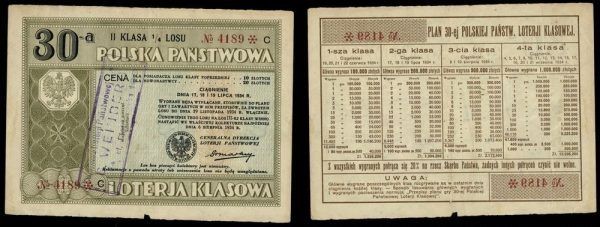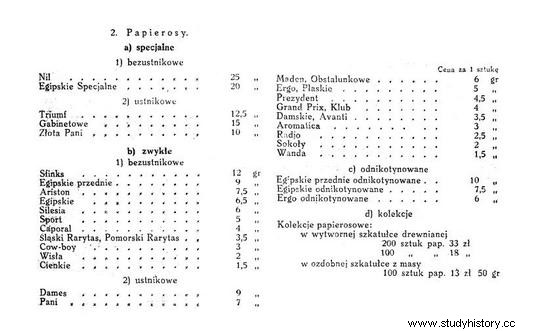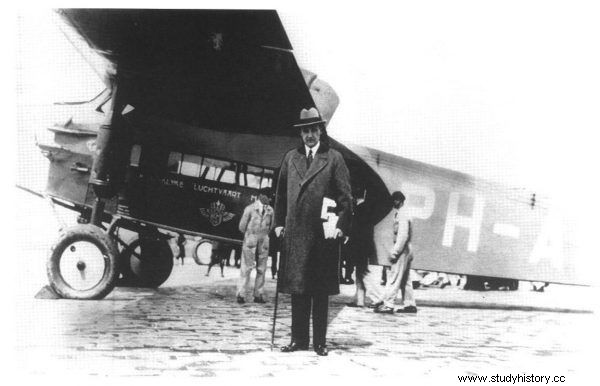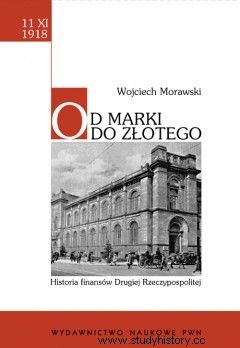Monopoly. The word that makes a hair on the head of every supporter of the free market. So what did the economic liberals have to feel in interwar Poland, where one-third of budget revenues came from treasury monopolies?
In the "Modern Illustrated Encyclopedia", published at the end of the Second Polish Republic, the slogan devoted to treasury monopolies was two pages long and began with the words: TREASURY MONOPOLIES, monopolies exploited by the state for fiscal reasons are special [this] form of collecting food taxes ( -> Excise).
In a more understandable language, monopolies were state-owned companies that had exclusivity in some part of the market or the right to provide certain services.
The first monopoly that did not exist
In the historical literature, you can find information that the first treasury monopoly was established in 1919, the monopoly of natural gas exploitation . However, it was to be quickly liquidated due to the meager income it generated. We can read about it, for example, in the entry in the "Encyclopedia of the History of the Second Polish Republic".

The building at pl. Bankowy 3 in Warsaw. It was in this building that the Minister of the Treasury, who was subject to such profitable treasury monopolies, was in office in the Second Polish Republic.
There is, however, a hitch. There has never been such a monopoly, which is emphasized in the book “From the brand to the zloty. The history of finances of the Second Republic of Poland ”prof. Wojciech Morawski. Therefore the first treasury monopoly should be considered the lottery monopoly organized in 1920, controlling numerical lotteries .
Initially, it was the Polish Class State Lottery, transformed in 1936 into the Polish Lottery Monopoly. Classism in the name, of course, had nothing to do with socialist or communist ideology. It was due to the fact that each lottery was divided into four classes.
The totalizer, as well as raffle and cash lotteries organized for charity and public utility purposes remained outside the monopoly. In this case, however, a permit was needed from an appropriate institution (for example, the Ministry of Treasury or the Excise Office).

This was the fate in the Polish National Class Lottery - in this case, the 2nd class.
In the second half of the 1930s, there were three nationwide lotteries a year which were subject to the lottery monopoly. The monopoly fee was as much as 20% of the coupon price - 18% went to the State Treasury. In the financial year 1935/36, the income on this account amounted to PLN 22 million. The sum is quite good, but it is nothing compared to the revenues generated by the Polish Tobacco Monopoly.
Smoking and alcohol drinks

Egyptian Przednie, i.e. medium-range cigarettes, for which in 1933 you paid nine groszy apiece.
The tobacco monopoly was the legacy of the partitioning powers . Before 1918, it functioned in Galicia and territories under Russian control. The Act of June 1922 extended it to the whole country. The Polish Tobacco Monopoly governed the production, import and sale of tobacco and tobacco products.
In 1924, his property and income from the sale of tobacco products served as security for a very unfavorable loan taken by the government of Władysław Grabski at Banca Commerciale Italiana.
The loan, amounting to the equivalent of 87 million zlotys at that time, had horrendously high interest rates. What was worse, she forced the Polish side to buy large amounts of poor quality Italian tobacco.
Nevertheless - as it was written in the "Modern Illustrated Encyclopedia": Mon [opol] Tyt [ony] is one of the most important sources of income for the Polish Treasury [iego] , never failing, however severely diminished during the economic crisis [hi] . These words perfectly reflect the monopoly of the state's finances. In the financial year 1935/36 alone, the proceeds from this amounted to as much as PLN 340 million.

Excerpt from the ordinance of the Minister of the Treasury of December 31, 1932, which established the tariff for tobacco products. In this case, they are cigarettes.
As a curiosity, it should be added that the prices of tobacco products were determined by a special ordinance of the Minister of the Treasury . And so in 1933 a smoker who liked really good cigarettes paid, for example, a trifle of Egyptian Special Cents (approximately two modern zlotys). Those who could not afford such luxuries had to please you with Sports or Falcons, which cost five and two cents apiece respectively.
Another monopoly that brought the State Treasury a lot of income was the State Spirits Monopoly, established in July 1924. Władysław Grabski was behind its creation, who wanted to increase budget revenues after the currency reform that had just been carried out.
The idea, however, was not particularly original, as from 1896 such a monopoly functioned in the Russian partition. As we can read in the "Encyclopedia of the History of the Second Polish Republic:
The subject of the monopoly were:purchase and sale of spirit for consumption within the state borders, production and sale of pure vodkas, spirit tainting and bottling; the permit was required for the production, purification and dehydration of spirit, production of quality vodka, vinegar, acetic acid, yeast and storage of spirit and its products.
These restrictions did not apply to alcoholic beverages with less than 4.5%.
The income generated by the State Spirits Monopoly was significant and in the last years of the Second Republic of Poland it was constantly growing. And so, in the financial year 1935/36, they amounted to PLN 220 million, and three years later they would increase to PLN 418 million ( about 9% of tax revenues therefore came from the production of alcohol ).
Salt and suspicious match machinations
The year 1925 saw the creation of two more monopolies:the Polish Salt Monopoly and the State Match Monopoly. The first of them was a continuation of the monopolies already existing in the Austrian and Russian partitions and reserved the state the exclusive right to sell salt. In the financial year 1935/36, the proceeds from it amounted to PLN 46 million.

There was also a match monopoly in the Second Polish Republic.
A more interesting story is associated with National Match Monopoly . It did not exist during the partitions and was created in connection with the talks on the so-called "match" loan. It was to be granted to Poland by the Swedish tycoon in the production of matches, Ivar Kreuger, who wanted to create a world match monopoly.
Under unclear circumstances, our government agreed to the Swede's terms in return for a loan of only six million dollars. Although Kreuger himself counted that it would be up to 30 million. On the surface, the contract was favorable, the interest rate was 7%, and the repayment period was extended to 20 years.
The devil, however, was in the details as always. Because as J. Tomaszewski and L. Landau write in the book "Poland in Europe and the World 1918-1939": Almost every point of the agreement contained understatements, which the Swedes used to their advantage.

The Swede Ivar Kreuger was going to create a world match monopoly. Taking over the trade in this commodity in Poland was only one of the steps towards this. In the photo, the entrepreneur is going on a business trip by passenger plane (source:public domain).
As a result, Kreuger earned an annual income of around 30% in relation to the invested capital. The loan and the creation of a monopoly had another effect. Namely, during the period of cooperation with the Scandinavians, the production of matches in Poland decreased from 170,000 boxes in 1923 to only 77,000 in 1938. Exports decreased from 21,500 boxes to less than two thousand, and the number of active factories from nineteen to four.
This, of course, entailed a drastic reduction in jobs. Employment decreased from 4,851 to 805 people. Do we need better evidence that all monopolies are harmful to the economy?

The article was based on, among others, the book by Wojciech Morawski "From the brand to the zloty" (PWN, 2008).
Finally, it is worth mentioning that in the 1930s monopolies were organized in the form of state-owned enterprises with legal personality and operated on a commercial basis. At the same time, they were exempted from all state tributes.
The exception was the benefits for the State Road Fund as well as municipal taxes and fees. The profits themselves from them were considerable. They provided 22.2% (1924/25) to 34.4% (1935/36) of budget revenues.
Bibliography:
- Czesław Brzoza, Andrzej L. Sowa, History of Poland 1918-1945 , Krakow 2007.
- Encyclopedia of the History of the Second Polish Republic , ed. of science. Andrzej Garlicki, Warsaw 1999.
- Leszek J. Jasiński, Closer to the center or on the periphery. Polish economic contacts with foreign countries in the 20th century, Warsaw 2011.
- Wojciech Morawski, From brand to zloty. History of the finances of the Second Republic of Poland , Warsaw 2008.
- Modern Illustrated Encyclopedia , Warsaw [1937].
- Jerzy Tomaszewski, Zbigniew Landau, Poland in Europe and the world 1918-1939 , Warsaw 2005.
